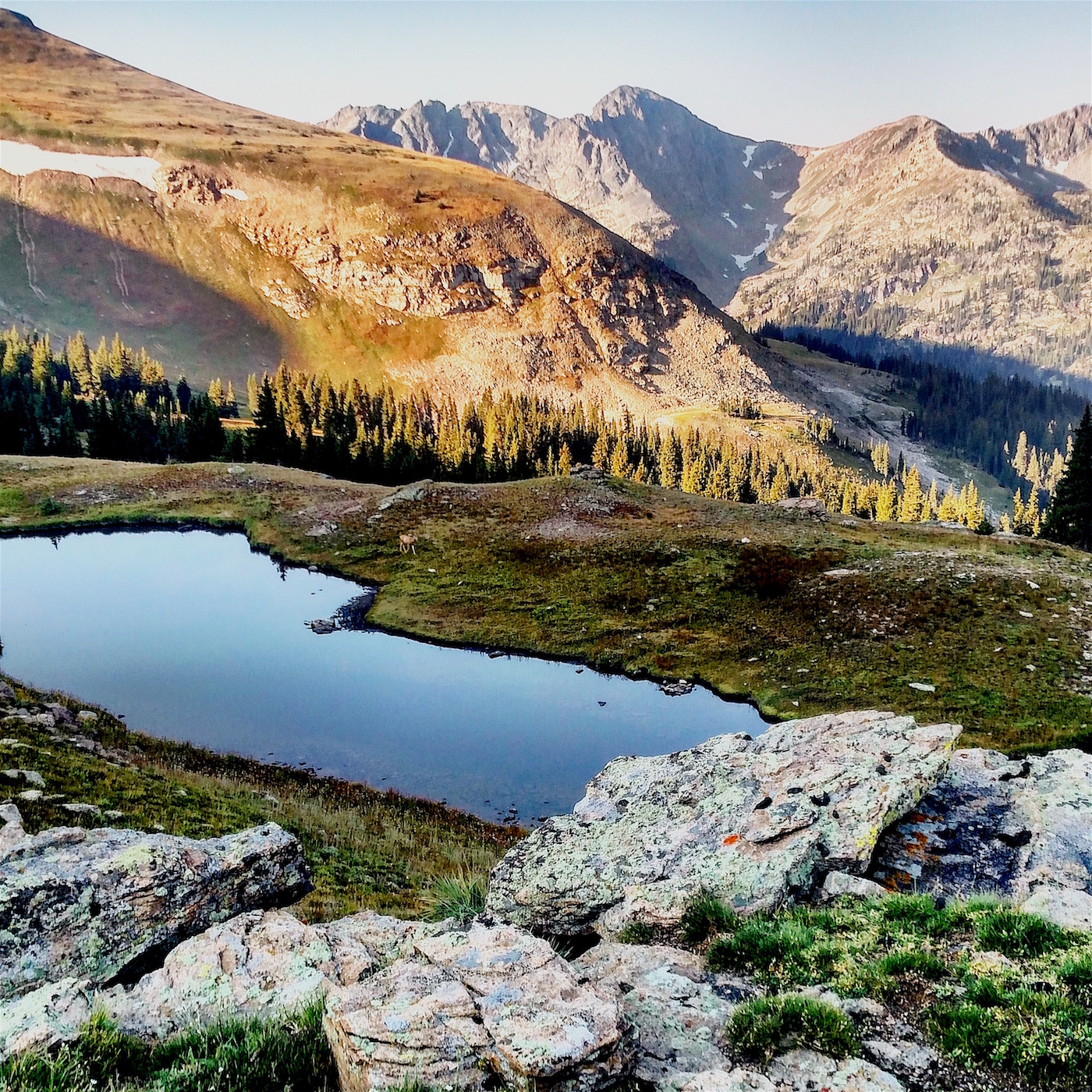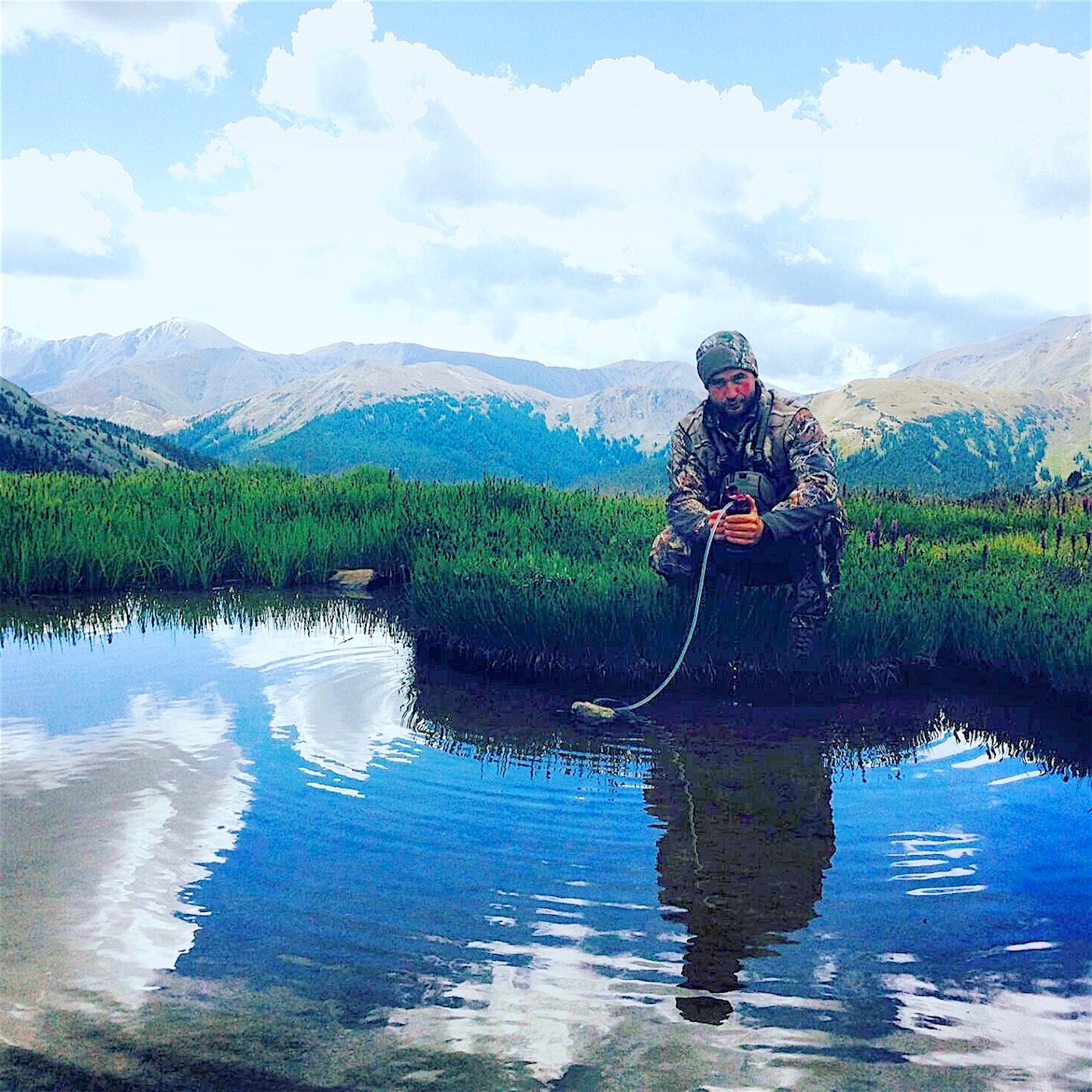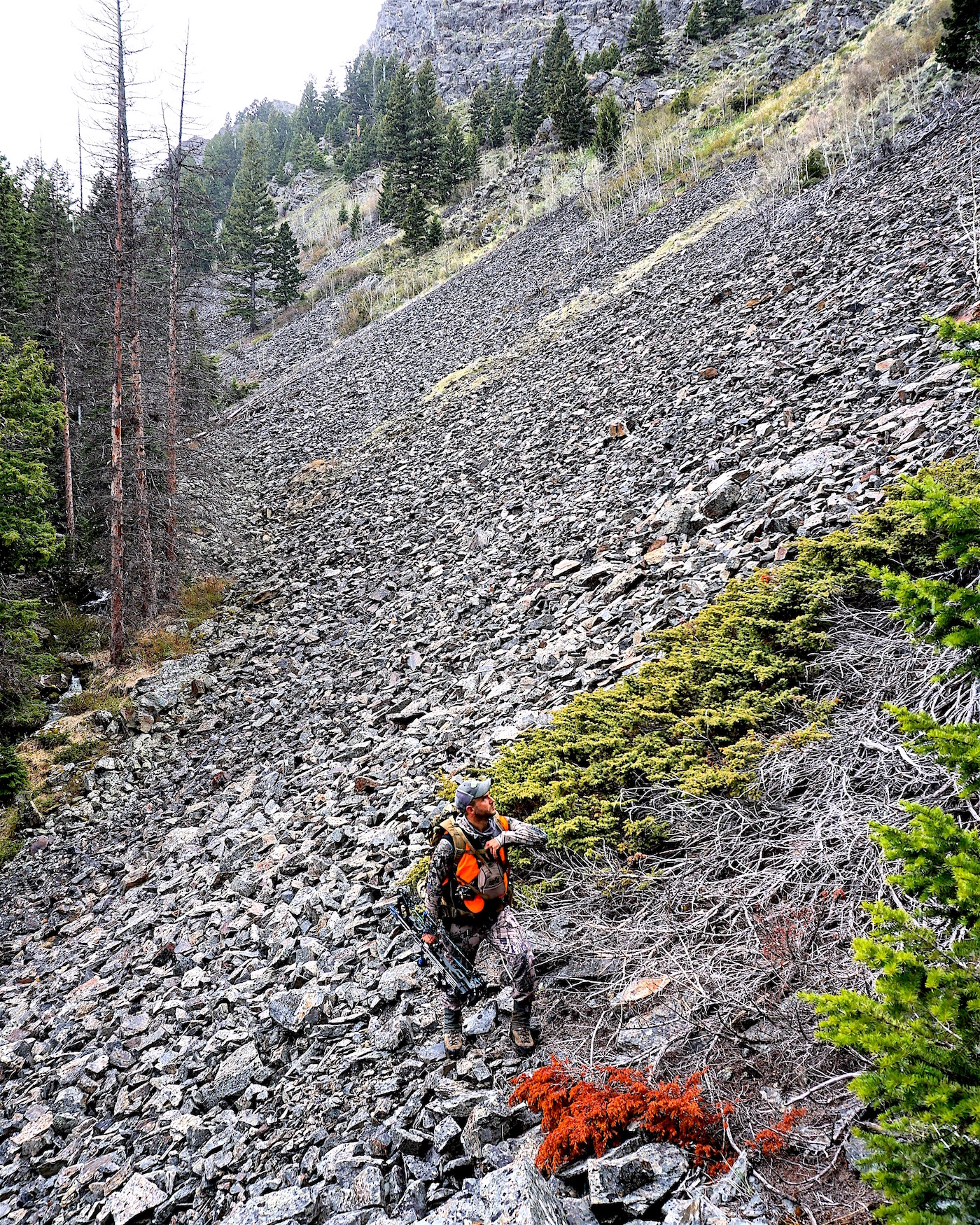As the beads of sweat dripped off my forehead and slowly ran down onto my face, I couldn’t help but feel a sense of urgency and restlessness. Carefully, I had snuck all the way around the basin and strategically placed myself right above the bachelor group of bucks, where the old, grey ghost I was after had bedded. As a slight breeze hit the side of my face, I felt relieved that the afternoon winds and thermals were now in my favor and began my descent down onto this buck. Inching my way ever so quietly, I couldn’t help but think back to the past five days of pure struggle and pain, combined with adrenaline and hope. I had been through it all up to this point: wind, lightning, hail, snow, and fluctuating temperatures, but none of that mattered now. I was present, I was in the moment, and I was ready to capitalize. My rangefinder lit up and showed 67 yards as I zeroed in on the buck’s velvet-covered antlers to check my distances. I knew it was all-or-nothing, and every move had to be a calculated maneuver.
I unlaced my boots and slowly took them off, anticipating the sharp rocks and thorns that would lie ahead, but not even these obstacles could wipe the smile off of my face. I was in the red zone and it was time to strike. Calming my nerves I slowly came to full draw. I could feel the muscles in my back tighten up as I slowly started to settle into my shot. Picking out a single hair just behind this buck’s shoulder, I settled my pin and went into auto-pilot. “Aim, aim, aim,” I told myself before my arrow suddenly buried into the dark, grey body.
For the last two years this scenario is all that I have thought about. I’ve replayed this stalk a million times over in my head, even though I’ve never arrowed a mule deer buck. Yet. Two years, four different trips, and a ton of miles have got me to where I am today: still super sick for a mule deer buck. Although I’d love to be writing an article about the 200-incher that I just shot, instead I’ll be focusing on what I’ve learned and experienced. Replaying back the good, the bad, the happy, and the sad moments that I’ve endured from the last two seasons of chasing these magnificent animals around on public land with my bow. I hope you enjoy and learn something from my adventures and can appreciate that it’s not just about killing, but it’s about the love of the game.
Homework
I fell in love with mule deer as soon as I saw them in a Field and Stream magazine years ago. Their dark grey coats combined with those wide, massive racks just did something to me right away. As I got older, I really began to think about bowhunting the West and matching wits with these bad boys, which led to me sitting behind a computer screen and frantically searching magazines and books for as much information as I could soak up. Planning an out-of-state mule deer hunt is hard work. It’s HARD WORK, but well worth it. Researching tags, units, zones, areas, and states — whether on a computer screen or via hard copy — is a necessity if you want to wrap your tag around a heavy, old muley buck.
I’ll never forget my first trip to Colorado in search of some early season velvet. I had researched the unit I had drawn for months and months and was honestly beginning to feel like I had lived in this section of the world half my life. It sure paid off because I had multiple plans already in my head in case my first few went south. Good thing I had done my homework, because Plan A and Plan B both got sunk when I ran into tons of hikers and lots of hunting pressure in both of these areas. Luckily for me, Plan C had no pressure and I was into bucks the first morning. The moral of the story here is the more scouting, researching, and planning you do, the more successful you’ll be. You will probably only have a few days or a week to get this tag punched, so make every second count and have multiple game plans in place. This saves you time and energy in the field and keeps you in the game. This is your hunt, so embrace everything that comes with it. I love this element of the hunt because the outcome falls only on me. Like a good bricklayer takes great pride in every piece, I too take pride in all the homework and scouting that I do — and you should, too. The scouting and homework you put in now will only make it sweeter when you get your hands around a massive set of antlers.
Grit and the Learning Curve
To sum up what it takes to hunt mule deer on public land, I’ll use one word: grit. If you don’t have it, don’t even attempt a mule deer hunt. Hunting muleys is a game of trial and error, and unfortunately I’ve been on the error side more than I’d like to admit. Attention to the details in hunting a mature, floppy-eared giant out west is imperative if you want to be successful: playing the mountain winds, watching thermals, timing the stalk correctly, looking out for other animals that could blow everything, etc. This can all be overwhelming, but grit is what will get you through the learning curve. Being able to accept defeat and learning from it is a necessity in the game of mule deer hunting.
My first year in Colorado found me making a great stalk on a bedded giant. His dark, heavy rack and giant fronts had me mesmerized and I just couldn’t wait to get my hands on him. The perfect stalk was playing out, and there was no way it could go wrong; or so I thought. With the sun rising and the wind in my face I started making my way towards this buck ever so slowly. I crept within 100 yards before taking my boots off and calmly starting my stalk again. Unfortunately I hadn’t accounted for the thermals rising as the sun heated up the daytime air. As I cautiously made my way towards this band of bucks, the changing thermals gently floated towards them. The learning curve was about to bite me right in the wheel house.
I almost cried when I peeked over a string of rocks to see the group of bucks heading directly away from me. “What could have happened!?” I thought. Bewildered, I checked the wind, and to my surprise the thermals had pushed my air current right up into the bucks’ noses. The learning curve had struck and I was left to wonder and ponder what might have been. But grit kept me in the game and two days later found me making a stalk on another good buck. This is a tough bowhunt. We know this from the start and that’s why we do it. A gritty attitude is a must if you’re going to stay positive; just keep pushing through. Who knows what’s over the next saddle!
East meets West
Growing up in Ohio, a lot of my bowhunting involves playing the chess game from 25 feet up. Sitting in treestands and blinds strategically placed in spots where chances are high to run into a good buck are how I spend most of my fall and winter days. Some may think that this style of hunting wouldn’t really help you out on a western excursion, but that couldn’t be further from the truth.
With rifle season starting the week prior to my arrival, I knew that I would be hunting pressured bucks with my bow. Each and every morning when I crawled out of my tent, I’d put my orange vest on with great pride — like a sheriff putting his badge on — because I knew how hard a bow hunt in the rifle season could be; but that never discouraged me. I wanted to accomplish this feat something terrible. My plan was to cover as many hide-away spots as I could in hopes of turning up a good buck bedded down somewhere in a hole where no gun hunters would find him. After day three I realized that this was going to be tougher than I thought.
Frantically looking at maps on my phone had me very concerned with what I had been seeing. “These deer have to be here somewhere,” I recall thinking to myself. But where? Then it hit me. Back home in Ohio, during gun season a smart bowhunter still holding his tag will hunt funnels — saddles and escape routes — during this time of the year. Bucks will be pushed from their daytime haunts and forced to move out of these holes and into other unpressured areas. This strategy has worked for me time and time again, so I was thinking maybe it could work for a muley buck as well.
Instead of searching for basins and secret hiding spots with tons of glassing, the next few days found me sitting on the upwind side of saddles surrounding the areas where I thought bucks would be. It paid off. It was like I was back home in the Buckeye state, only without a treestand. Each and every morning I’d get to a saddle well before daylight and spend the day glassing and waiting, and every day I got into deer — some good bucks, too. Rifle hunters were pushing them right into my lap! If it wasn’t for a bad yardage determination, I would have punched my tag on a gorgeous buck on day five as he snuck up over a saddle at last light.
My point here is: don’t be afraid to try something new. Playing the waiting game and having patience, like I would do back home, instead of pounding the hills and frantically walking for miles upon miles, is the only reason this hunt went from bad to good. Had I not changed tactics and used my eastern skills on this hunt, I would have been lucky to even get into any deer at all, since they were hanging tight all day and only moving when bumped. Using different tactics and staying open-minded when other plans aren’t working or producing is a must, and sometimes you just have to try something unorthodox in a new situation for success.
Mind Games
Two long, cold days had gone by since I last saw a mule deer. For early September the Colorado weather was about as bad as it could be. Cold, snow, and piercing north winds were making this hunt tough. I needed to get into deer because time was not on my side. With only a few days left, I decided to move camp and try a new plan. Physically I was drained each and every day, but I knew that mentally I had to stay in the game. I couldn’t let my mind wander or lose focus if I wanted to succeed at the task at hand. So I moved camp late one evening; in the cold, bone-chilling wind I trudged along up over the saddle and down into a new basin some three miles away. The next morning I was granted a pleasant surprise: mule deer below me in a meadow, feeding. The move had worked, and keeping a positive attitude and not giving up is why I got back into deer. Sure, it would have been easier to stay put, give up, and just accept defeat. That simply wasn’t an acceptable option. I had to find deer, and no matter what, I was going to do just that!
The moral of this experience is that focus is a key ingredient to success on these bowhunts. Mentally, a hunter must stay in the game or he will not succeed. I’ll even take mental resolve over physical toughness. Letting the mind wander will diminish your chances and keep you out of the game.
Look at it like this: we choose to do these hunts. They’re supposed to be our getaway; fun, exciting, and the stuff we bowhunters dream about all year. Don’t cut yourself short by mentally letting your mind go. Stay positive; think about how lucky you are to be where you are. Envision how awesome it will be to hold that giant buck’s rack. Imagine the excitement of sending those successful text messages back home to your family and friends.
Keep the mind focused on the task at hand. We all miss our friends and family. These hunts can be super tough, and at times nearly impossible, but we know they’re not. We know we can punch the tag, so we must keep the mind games working in our favor. Don’t let negativity and bad thoughts ruin your trip and take away from great experiences. Trust me, if you end up leaving early, you’ll regret it every single day, no matter how tough things may be. Stay mentally in the game and you’ll see more mule deer; it’s as simple as that.
The Why
At this point, some of you are probably wondering, why does this crazy guy continue to keep chasing these bucks around with a bow and not just grab the rifle? Or, perhaps you’re wondering why I haven’t become discouraged or given up yet? Well to be honest, the answer is simple: I love bowhunting, and the harder it is, the more I love it. I believe I was born to hunt mule deer. The beautiful country captivates me, and I find their behavior breathtaking. Go on a high-country mule deer hunt in late August and you’ll see exactly what I’m talking about. These animals are so challenging with a bow that I just can’t get enough of it. They inspire me every day to be a better bowhunter than yesterday, and I cannot wait to finally punch that first mule deer buck tag.
But, punching a tag isn’t why I do it. I do it and will continue to do it year in and year out because I love bowhunting mule deer; especially the unpredictable challenges that these hunts present. I enjoy the struggles and pain because I know that two minutes later could be the moment that it finally happens. I’m driven to find the remote places that these bucks live in that see minimal human activity. I’m enthralled by the sights, sounds, and experiences that I encounter while hunting these animals in their own environment, on their own terms. I bowhunt mule deer because of my love of the game, and I hope that you will too.
MOUNTAIN ARCHER IS BROUGHT TO YOU BY MATHEWS INC.





